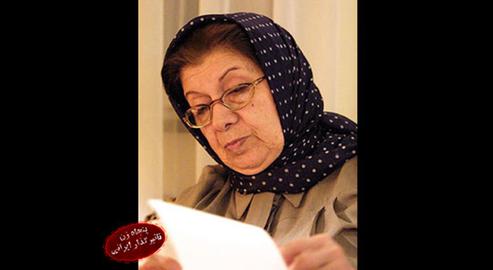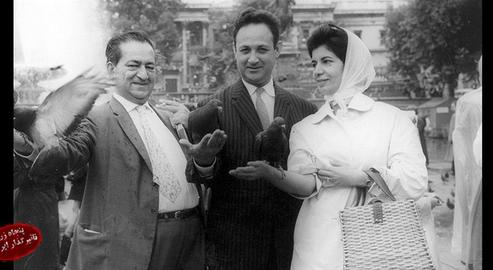Global and Iranian history are both closely intertwined with the lives and destinies of prominent figures. Every one of them has laid a brick on history's wall, sometimes paying the price with their lives, men and women alike. Women have been especially influential in the last 200 years, writing much of contemporary Iranian history.
In Iran, women have increased public awareness about gender discrimination, raised the profile of and improved women's rights, fought for literacy among women, and promoted the social status of women by counteracting religious pressures, participating in scientific projects, being involved in politics, influencing music, and cinema. And so the list goes on.
This series aims to celebrate these renowned and respected Iranian women. They are women who represent the millions of women that influence their families and societies on a daily basis. Not all of the people profiled in the series are endorsed by IranWire, but their influence and impact cannot be overlooked. These articles are biographical stories that consider the lives of influential women in Iran.
IranWire readers are invited to send in suggestions for how we might expand the series. Contact IranWire via email ([email protected]), on Facebook, or by tweeting us.
On April 11, 2012 the media reported the death of “the wife of” Abdolhossein Zarrinkoub, a prominent scholar of Iranian literature. With these dismissive pronouncements, outlets omitted to mention that both before and after to her marriage to "Abdol", Ghamar Aryan was in fact an Iranian cultural heavyweight herself. One of the first female gradates of the Faculty of Literature at Tehran University, she had taught ancient literature alongside such titans as Badiozzaman Forouzanfar and Mohammad Ali Foroughi.
Ghamar Aryan played a vital role both in lecturing at Tehran University and in research that enriched the cultural life of Iran. Even in her final years of life, she did not abandon either of these pursuits, allocating her small apartment in Behjatabad, Tehran for gatherings of young researchers. She was a woman of breathtaking knowledge whose life and death were both intertwined with the first month of the Iranian calendar, March.
Growing Up Gifted
Aryan was born in March 1922 in Quchan, Khorasan province. Her father, Mirza Abdolvahhab Aryan, was an academic and an influential figure of that city. With the birth of his daughter, he decided to build the first girls' school in Quchan. The school, which taught the first six grades, was run by literate and elite local women.
The young Ghamar completed her sixth grade there and as she was clearly gifted, her father hired a private teacher to continue her education for another three years. She then studied her tenth and eleventh grade at an elementary teachers' college in the city of Mashhad, while also teaching sixth grade at a primary school.
At that time, since the only Iranian university at the time was in Tehran, Ghamar wrote a letter to her father asking his permission to join her brothers there. One of her brothers was studying medicine, and the other physics, at Tehran University. With his blessing she sat the entrance examination a decade after the university had first opened its doors, and amid the tumult of the Second World War. She passed the exam comfortably and began to study literature.
At that time, great masters including Jalaluddin Homaei, Mohammad Moin, and Zabihollah Safa taught at the university. On obtaining her bachelor's degree, Aryan decided to remain in Tehran and would eventually pursue a PhD.
Higher Education in Turbulent Times
Aryan’s university years took place at a time opposition to a literary school set up by Nima Yushij, a famous contemporary poet, was reaching boiling point. She met Nima for the first time herself at the age of 23. "I really liked most of Nima's works and poems,” she would later recall. “Each time I read his Simorqh or Afsaneh I really enjoyed it, especially because he had freed poetry from shackles of rhyme. That is why I wanted to see him.
“I was at a party when I realized Nima was there too. Immediately I went to him and shouted, ‘You, sir, are you Nima?’. He said, ‘Yes, ma’am. Am I just an ordinary man, for you to address me that way?’. I said, ‘You are more than that. You are the best poet I know. I’m just so happy to see you in person."
At the university, through her classes on History of Religions, Aryan came to know about Christian religious teachings and after reading the New Testament, though she had already studied the life and works of Rumi and his contemporaries, she decided to write her PhD thesis on The Face of Christianity in Persian Literature.
In an interview some years later, she explained the reason for her choice: "When I was writing my thesis, doing research on other religions was not fashionable. While reading the New Testament, I wished others, too, would become more familiar with this religion.”
This period of study coincided with the United States-backed coup of August 19, 1953, followed by the trial of former Iranian prime minister Mohammed Mosaddegh. In interviews, Aryan has repeatedly said the trial was one of the important experiences of her life, which she will never forget. The image of Mosaddegh, pioneer of the nationalization of the Iranian oil industry, would remain in her mind forever.
Aryan regarded the trial as "the trial of humanity against infamy and treachery" and has spoken of Mosaddegh's resistance to the courtroom and his candid disclosure of the treacheries the government of the day had covered up.
Half a Century of Companionship and Achievement
It was during this period that Aryan would meet her future life companion of 50 years, Abdolhossein Zarrinkoub, or Abdol, as she called him.
"I came to know Dr. Zarrinkoub in the department of Persian Literature,” she later said. “He had come to the university the year before, but had left because at that time the allied forces had occupied Iran and Tehran was in turmoil.
“We had both enrolled in the same year. He was a brilliant student. I was relatively good too. I often could see that his knowledge exceeded that of the lecturers, and I sought his help in my studies. We were classmates in the majority of the modules, even at doctorate level."
Their courtship lasted for nine years. Finally the pair traveled to Mashhad for Zarinkoub to formally ask Aryan’s father for her hand in marriage.
"I realized that I really needed Abdol,” Aryan later reflected, “because there were a thousand things that I wanted to know and he was the only person who knew them. So when he proposed to me, I accepted, and we went to my parents in Mashhad.
“When I told my father that Mr. Zarinkoub, a man of literature and research, had proposed to me, my father said he had read his articles and he must be an old man. I told him ‘He’s only 30.’ My father said, ‘The author of those articles sounds much older.’ Everybody said that."
They married in 1953, and both received their PhDs in the same year. They lived together for more than 50 years together. Though they had no children, their marriage was the cradle of valuable academic treatises such as The History of Iran, Two Centuries of Silence, Times, and so on, authored by Zarinkoub, and Woman in the Koran and Kamaledin Behzad by Aryan, as well as numerous co-authored works including Ney Nameh (Epistle of the Shepherd Pipe) and Iran: Country of Culture and Art.
The couple began travelling extensively after obtaining their doctorates. They spent several years in India, the United States, Lebanon and several European and Arab countries. Zarinkoub’s Near East in History was written while teaching at the University of California, Los Angeles and at the University of Princeton as a visiting lecturer, and translated into English by his wife. She also translated Bertold Spuler's The World of Islam, a narrative of the Persian and Ottoman Empires.
On returning home from the US, Aryan became the director of Tehran Painting College, where many now-famous figures of Iranian contemporary art studied, including Massoud Arabshahi and Sadegh Tabrizi.
Read other articles in this series:
The Women's Clandestine Union, Anonymous Political Agitators
Roshanak Nodust, Headmistress of Saadat School
Mahshid Amirshahi, Writer, Journalist and Satirist
Ashraf Bahador-Zadeh, Iran’s Mother Teresa
Razieh Ebrahimzadeh, Wanderer and Communist Firebrand
Malektaj Firouz Najm ol-Saltaneh, Founder of Tehran's First Modern Hospital
visit the accountability section
In this section of Iran Wire, you can contact the officials and launch your campaign for various problems



























comments